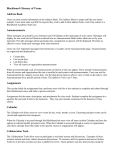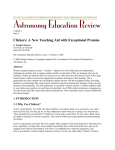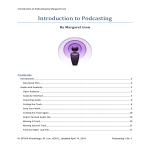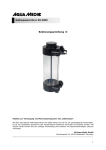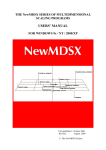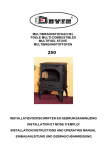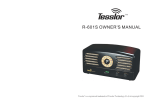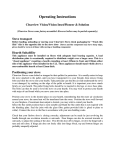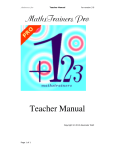Download Interactive Learning: Using Research to Promote Student
Transcript
Enseignement interactif en cours magistral Alexander L. Rudolph Department of Physics and Astronomy California State Polytechnic University (Cal Poly Pomona) et Professeur Invité, UPMC Université de Pierre et Marie Curie 26 Janvier 2012 Please take 0930-1230 a clicker! Brief introductions Aperçu de l’atelier • What is Interactive Learning? — Think-pair-share (TPS) questions — Tutorials (next Thursday) • Implementation challenges and solutions • Creating your own question • Practicing! What are clickers? • Classroom response systems (“clickers”) are remote controls which can submit answers to the instructor’s computer via an RF receiver • The instructor can see the results of the student responses in real time • These results can also be displayed graphically • Clickers are used to provide the instructor (and students) with real-time feedback about student understanding of a topic or concept What are clickers? • Clickers are not the only way to promote interactive learning in your classroom, as we will see today Let’s try them out Please choose the most appropriate answer. A) I attended your presentation in June 2010 B) I attended your presentation in October 2011 C) I attended both presentations D) I didn’t attend either presentation E) What presentations? Who are you? I think I am in the wrong room! Quelques citations pour encadrer la discussion Some Quotes to Frame Our Discussion Car l'esprit n'est pas comme un vase qu'il ne faille que remplir. A la façon du bois, il a plutôt besoin d'un aliment qui l'échauffe, qui fait naître en lui une impulsion inventive et l'entraîne avidement en direction de la vérité. A mind is a fire to be kindled, not a vessel to be filled Plutarch Ce n'est pas que le professeur fait qui a d'importance ; plutôt, c'est que les étudiants font It's not what the teacher does that matters; rather, it is what the students do L'erreur pédagogique fatale est de donner des réponses aux étudiants qui n'ont pas des questions The fatal pedagogical error is to give answers to students who do not yet have questions Before we begin — burning questions pad What is Interactive Learning? Interactive Learning is a tool that can change the way students learn! A Commonly Held Inaccurate Model of Teaching and Learning from How People Learn “Students enter your lecture hall with preconceptions about how the world works. If their initial understanding is not engaged, they may fail to grasp the new concepts and information that are taught, or they may learn them for the purposes of a test but revert to their preconceptions outside the classroom” HOW PEOPLE LEARN, National Research Council National Academy Press, 2000. A cautionary tale… …about a violin From Carl Weiman’s* “Physics of Everyday Life” class, Univ. of Colo. *Nobel prize winner AND good teacher Teaching is not telling… Learning is not listening • Weiman reports the following example of trying to teach how a violin works—that the body of a violin is essential for amplifying the sound of the strings • Most students have the preconception that the strings make all the sound • Explaining about sound and how a violin works, he shows the class a violin and tells them that the strings cannot move enough air to produce much sound, so actually the sound comes from the wood in the back • 15 minutes later in the lecture he asked students a question—the sound they hear from a violin is produced a. mostly by the strings, b. mostly by the wood in the violin back, c. both equally, d. none of the above Teaching is not telling… Learning is not listening • Weiman reports the following example of trying to teach how a violin works—that the body of a violin is essential for amplifying the sound of the strings • Most students have the preconception that the strings make all the sound • Explaining about sound and how a violin works, he shows the class a violin and tells them that the strings cannot move enough air to produce much sound, so actually the sound comes from the wood in the back • 15 minutes later in the lecture he asked students a question—the sound they hear from a violin is produced a. mostly by the strings, b. mostly by the wood in the violin back, c. both equally, d. none of the above Teaching is not telling… Learning is not listening • Weiman reports the following example of trying to teach how a violin works—that the body of a violin is essential for amplifying the sound of the strings • Most students have the preconception that the strings make all the sound • Explaining about sound and how a violin works, he shows the class a violin and tells them that the strings cannot move enough air to produce much sound, so actually the sound comes from the wood in the back • 15 minutes later in the lecture he asked students a question—the sound they hear from a violin is produced a. mostly by the strings, b. mostly by the wood in the violin back, c. both equally, d. none of the above Teaching is not telling… Learning is not listening • Weiman reports the following example of trying to teach how a violin works—that the body of a violin is essential for amplifying the sound of the strings • Most students have the preconception that the strings make all the sound • Explaining about sound and how a violin works, he shows the class a violin and tells them that the strings cannot move enough air to produce much sound, so actually the sound comes from the wood in the back • 15 minutes later in the lecture he asked students a question—the sound they hear from a violin is produced a. mostly by the strings, b. mostly by the wood in the violin back, c. both equally, d. none of the above What fraction of the students got the right answer? A) B) C) D) E) 0% 10% 30% 70% 90% B) Only 10% of students gave the correct answer. Fifteen minutes later in the same lecture! Teaching by telling is surprisingly ineffective… …if you want student to master concepts. Minds must be active to learn What is Interactive Learning? • Interactive Learning is a set of strategies to get students actively involved in their learning • Think-Pair-Share Questions • Tutorials and Ranking Tasks • Interactive Demonstrations • Interactive Learning uses a combination of lecture, real-time assessment, and peer interaction and instruction • Research* has shown that Interactive Learning Strategies lead to significant improvement in conceptual understanding by students compared with lecture alone *For more information on research into interactive learning, see my presentation from October 2011 at http://itunes.apple.com/WebObjects/MZStore.woa/wa/viewPodcast?id=479835182 Think-Pair-Share (TPS) Questions • • • • • • • Short (10-20 minute) lecture on topic “Think-Pair-Share” Question posed Students given time to think Students record individual answers Students discuss with their neighbors Students record revised answers Instructor leads class discussion Adapted from Eric Mazur, “Peer Instruction: A user’s manual” Classroom Response System – “High” Tech Classroom Response System – Low Tech GABII Class Response System – Low Tech Clickers v. Flashcards Clickers Flashcards Participation + + Interactive Questioning + + Feedback (to inst.) Feedback (to stud.) + + + Feedback Saved Credit + + Cost − − +/− Answer tied to student Class Time − − − + + +/− Question So, what’s the big deal with clickers and flashcards? Why not just use a show of hands? Some Answers 1) Herd instinct 2) Shy students don’t participate 3) Anonymity is desirable (surveys) 4) Sensitive topics (e.g., “Human Sexuality” class) Implementation is key!!!! Rule #1: simultaneous Rule #2: anonymous Rule #3: resist broadcasting/giving answers too early (or maybe at all!) Elements of best implementation of Think-Pair-Share (TPS) Questions 1. Instruct students that this question will give them feedback on whether they understand the concept you just presented 2. Be sure to indicate that they should try to answer the question themselves at first 3. Tell them they will have 30 seconds to answer (give them 45-60 seconds) 4. Do not read them the question 5. Read to yourself as if you are trying to answer the question. Allow enough time to go through the reasoning steps Elements of best implementation of Think-Pair-Share (TPS) Questions 1. If using clickers, you can start the question now 2. Give them a 15 or 10 second warning when the question will close. I usually count down the last 5 seconds Elements of best implementation of Think-Pair-Share (TPS) Questions 1. If using clickers, you can start the question now 2. Give them a 15 or 10 second warning when the question will close. I usually count down the last 5 seconds 3. If using flashcards, ask if anyone needs more time 4. If not, tell them to “Prepare to vote” 5. Say, “On the count of three, one…two…three… vote!” 6. At this time they should simultaneously hold up the cards to their chests Elements of best implementation of Think-Pair-Share (TPS) Questions 1. If using clickers, check the results on your screen using the histogram 2. Do not let them see the results of the first vote! Elements of best implementation of Think-Pair-Share (TPS) Questions 1. If using clickers, check the results on your screen using the histogram 2. Do not let them see the results of the first vote! 3. If using flashcards, estimate the percent correct by eye Elements of best implementation of Think-Pair-Share (TPS) Questions 1. If using clickers, check the results on your screen using the histogram 2. Do not let them see the results of the first vote! 3. If using flashcards, estimate the percent correct by eye 4. In either case, if the percent correct is >80-90% you can go on without another vote. You may want to review the reasoning for the correct answer (or better yet, have a student do it) Elements of best implementation of Think-Pair-Share (TPS) Questions 1. If the percent correct on the first vote is 50-80% (the sweet spot), you will instruct the students to talk to each other 2. Do not indicate anything about the distribution of answers 3. Say something like, “Interesting…there is some disagreement about the answer. Turn to you neighbor and try to convince them that you are right and they are wrong and why. Even if you have the same answer, it is very important to talk about your reasoning. You have 60 seconds, Go!” Elements of best implementation of Think-Pair-Share (TPS) Questions The key elements of these instructions are: 1. Telling them to convince their neighbor 2. Indicate the idea that they should argue believing they are right 3. Emphasize that it is the reasoning that counts, not the answer 4. Give a clear (short) time for them to talk 5. Give a clear indication to start “Go!” Elements of best implementation of Think-Pair-Share (TPS) Questions The key elements of these instructions are: 1. Telling them to convince their neighbor 2. Indicate the idea that they should argue believing they are right 3. Emphasize that it is the reasoning that counts, not the answer 4. Give a clear (short) time for them to talk 5. Give a clear indication to start “Go!” The critical goal of TPS is to create an authentic conversation between the students about the concept you want them to understand Elements of best implementation of Think-Pair-Share (TPS) Questions 1. After the students have talked for 60 seconds or so, you will stand somewhere they can all see you and say “Time!” 2. If you are using clickers, you will simply state “Vote again, you have 20 (or 30) seconds to vote” and start the question 3. If using flashcards, say again, “Prepare to vote, etc.” again 4. In either case, if the percent correct is >80-90% you can say, “That is much better, more of you now have the right answer” 5. In any case, you should review the reasoning for the correct answer (or better yet, have a student do it) 6. You can decide if you want to show them the second histogram of results (or tell them the right answer) Elements of best implementation of Think-Pair-Share (TPS) Questions 1. If the percent correct on the second vote is still below 80%, you have to decide what you will do 2. One possibility is to have two or three students state what they chose and why, and start a debate about the reasoning behind the answers. With your guidance, this can help students who are unsure to understand what is the correct answer and why 3. If the number of students with the correct answer is even lower (below 50-60%), you may want to consider additional instruction or some other intervention (e.g., work on concept in TD) Some Rules for Our Implementation of Think-Pair-Share (TPS) Questions If I (or any of you) do something wrong, yell, “Pause” to let us know to stop and discuss the implementation error This is Lunacy! The Moon remains in its orbit around the Earth rather than falling to the Earth because A. it is outside of the gravitational influence of the Earth B. it is in balance with the gravitational forces from the Sun and other planets C. the net force on the Moon is zero D. none of these E. all of these Two uniformly charged spheres are firmly fastened to and electrically insulated from frictionless pucks on an air table. The charge on sphere 2 is three times the charge on sphere 1. Which force diagram correctly shows the magnitude and direction of the electrostatic forces: Radial Velocity 1 Orbit of star +20 Earth 4 2 Time -20 Orbit of planet 3 Given the location marked on the star's radial velocity curve, at what location in the planet's orbit would you expect the planet to be? Peer Instruction Can Be Very Powerful Before Peer Instruction 100% After Peer Instruction 90% 80% 70% 60% 50% 40% 30% 20% 10% 0% A B C D E Sometimes Further Teaching is Needed Before Peer Instruction 100% After Peer Instruction 90% 80% 70% 60% 50% 40% 30% 20% 10% 0% A B C D E Effective Multiple Choice Questions Consider your answer to these questions about writing multiple-choice questions. In a multiple-choice question, when is the longest answer the correct answer? A. Rarely B. Sometimes C. It’s common for it to be the correct answer, and it’s often stuffed with new information that should have gone in the main part of the course but we forgot so now we’re putting it in the quiz because we can’t possibly leave out the tiniest detail D. Occasionally Adapted from: http://blog.cathy-moore.com/2007/08/can-you-answer-these-6-questions-about-multiple-choice-questions/ Consider your answer to these questions about writing multiple-choice questions. When is it NOT a good idea to avoid negative questions? A. Never B. Sometimes C. Always D. What? Adapted from: http://blog.cathy-moore.com/2007/08/can-you-answer-these-6-questions-about-multiple-choice-questions/ Consider your answer to these questions about writing multiple-choice questions. How often is the correct choice “A”? A. Usually B. Frequently C. Often D. Almost never, because if “A” is the right answer, then the learner doesn’t have to read all the other options we spent so much time writing and revising, and where’s the return on investment in that? Adapted from: http://blog.cathy-moore.com/2007/08/can-you-answer-these-6-questions-about-multiple-choice-questions/ Consider your answer to these questions about writing multiple-choice questions. When is “All of the above” the correct answer? A. With alarming regularity B. When we try to cover too much in one question C. When we use a question to teach instead of assess D. All of the above Adapted from: http://blog.cathy-moore.com/2007/08/can-you-answer-these-6-questions-about-multiple-choice-questions/ Consider your answer to these questions about writing multiple-choice questions. We can confuse learners when we: A. fail to actually complete the sentence we started in the question. B. inconsistent grammar in the options. C. sometimes we veer off into another idea entirely. D. wombats. Adapted from: http://blog.cathy-moore.com/2007/08/can-you-answer-these-6-questions-about-multiple-choice-questions/ 1. The promiscuous use of sprays, oils, and antiseptics in the nose during acute colds is a pernicious practice because it may have a deleterious effect on: A. the sinuses B. red blood cells C. white blood cells D. the olfactory nerve 2. Frequent use of sprays, oils, and antiseptics in the nose during a bad cold may result in: A. the spreading of the infection to the sinuses B. damage to the olfactory nerve C. destruction of white blood cells D. congestion of the mucous membrane in the nose 1. In 1965, the death rate from accidents of all types per 100,000 population in the 15-24 age group was: A. 59.0 B. 59.1 C. 59.2 D. 59.3 2. In 1965, the leading cause of death per 100,000 population in the 15-24 age group was from: A. respiratory disease B. rheumatic heart disease C. accidents D. cancer 1. About how many calories are recommended daily for a 14year old who is 62 in. tall, weighs 103 lbs., and is moderately active? A. 1,500 B. 2,000 C. 2,500 D. 3,000 2. About how many calories are recommended daily for a 14year old who is 62 in. tall, weighs 103 lbs., and is moderately active? A. 0 B 500 C. 2500 D. 10,000 Limitations to MC Questions and Tests - Constructing good items (stem and choices) is difficult and time consuming. - It is difficult to find/create plausible distracters. - Ineffective for measuring some types of problem solving and the ability to organize and express ideas. Real-world problem solving involves proposing a solution versus selecting a solution from a set of alternatives. - There is a lack of feedback on individual thought processes – it can be difficult to determine why individual students selected incorrect responses. - Often MC questions focus on factual information and fails to assess higher levels of cognitive thinking. - They place a high degree of dependence on the student’s reading ability and the instructor’s writing ability. Students can sometimes read more into the question than was intended. - May encourage guessing. Strengths of MC Questions and Tests - Learning outcomes from simple to complex can be measured. - Incorrect alternatives provide diagnostic information. - Scores are less influenced by guessing than true-false items. - Scoring is easy, objective, and reliable. - Can cover a lot of material very efficiently - Item analysis can reveal how difficult each item was and how well it discriminates between the strong and weaker students - Performance can be compared from class to class and year to year Helpful Hints to Constructing Questions and Tests • Base each item on an educational or instructional objective of the course, not trivial information. • Try to write items in which there is one and only one correct or clearly best answer. • The phrase that introduces the item (stem) should clearly state the problem. • Test only a single idea in each item. • Be sure wrong answer choices (distracters) are at least plausible. • Incorporate common student naïve ideas or reasoning difficulties in distracters. • The position of the correct answer should vary randomly from item to item. • Include from three to five options for each item. • Avoid overlapping alternatives • The length of the response options should be about the same within each item (preferably short). Helpful Hints to Constructing Questions and Tests • There should be no grammatical clues to the correct answer. • Word the stem positively; avoid negative phrasing such as “not” or “except.” If this cannot be avoided, the negative words should always be highlighted by underlining or capitalization: Which of the following is NOT an example …… • Avoid the excessive use of “All of the above” and “None of the above” in the response alternatives. In the case of “All of the above”, students only need to know that two of the options are correct (in a four or more option question) to determine that “All of the above” is the correct answer choice. Conversely, students only need to eliminate one answer choice as implausible in order to eliminate “All of the above” as an answer choice. Similarly, with “None of the above”, when used as the correct answer choice, information is gained about students’ ability to detect incorrect answers. However, the item does not reveal if students know the correct answer to the question. Do the questions you use intellectually challenging your students or simply asses their factual knowledge? Bloom’s Taxonomy of Educational Objectives evaluation synthesis analysis application comprehension declarative knowledge An Assessment Primer for Introductory Astronomy. Astronomy Education Review, 1(1), 124, 2002. G. Brissenden, T.F. Slater, and R. Matheiu. Create a suitable question to use for Think-Pair-Share • Work with a small group (3-4) • Make sure your question is multiple choice • Each of the members of your group will work together model “Think – Pair – Share” using your question On the topic of: If We Can Articulate What Learner-Centered Instruction Is & How It Improves Student Learning, Only Then Can We Be Effective At Implementation! • If you can’t discuss it, in your own words, and make sense of your beliefs to others, do you really understand it? How does learning occur during Think-Pair-Share? Who is responsible for doing the learning? • What are the learning and instructional goals when using TPS (for them and for you) • What is needed in terms of the question used? • When or why should you or should you NOT give answers? Some Ideas: TPS • When should you use TPS – did you provide the information they needed? • How to explain to students why you do this – get student buy in… • Why does it matter if the students talk to each other • Why does it matter if the questions are MC • What distinguishes a good MC from a bad MC question? • Should you show the results data at the end of the first voting before they pair • Do you read the question to them? • Sweet spot • Broadcast time to vote – provide time limit • Happy spot • How do you debrief after second voting? When, if ever, do you provide the right answer? • Clickers vs Cards and attendance/graded or not? L’avenir • Next Thursday there is a second workshop on “Enseignement interactif en TD” -- Tutorials • I am at UPMC for 5 months as a Professeur Invité and am available to work with faculty who wish to implement Interactive Learning in their classroom • I am already working with faculty in LP112 and LP 203 who are implementing both TPS and Tutorials • I can help with understanding the pedagogy, selection of materials, visiting classrooms to provide feedback • My office is 12-22-212 and my e-mail is [email protected] • Feel free to contact me if you would like to meet Questions and Discussion








































































